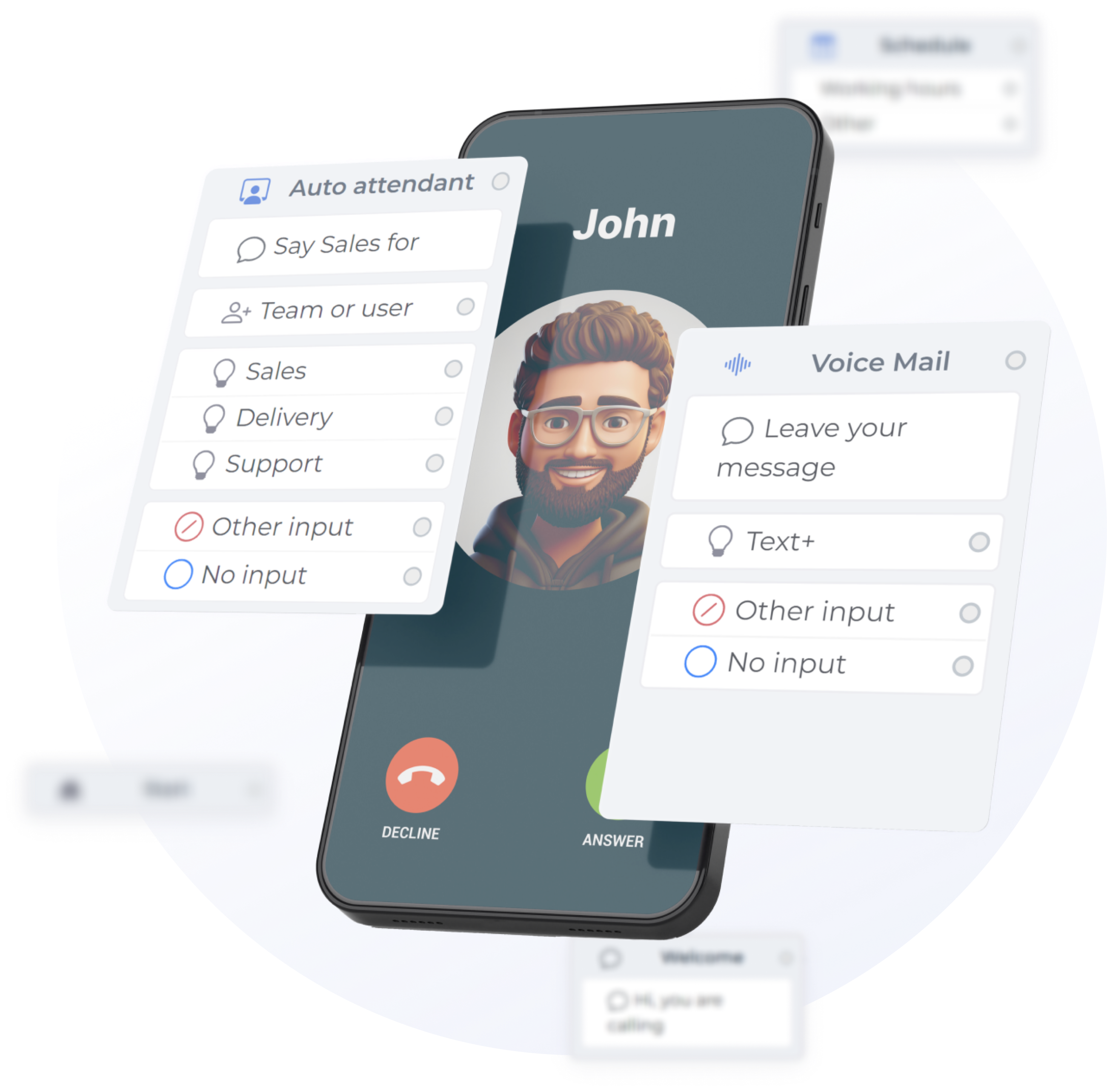Services and Tech Stack
Complex development services and technologies that help us create great solutions for your project.
Serviсes
Tech Stack
Cloud AI PBX
Coming soon
Cloud AI Contact Center
Coming soon

March 11, 2024
How and Why to Implement Automated Outbound Calls and Messages
Let’s See How These Features Can Benefit Your Business

With our platform, you can make your business operations smoother and faster due to fully automated outbound calling and messaging. Reach out to more people quickly, helping your team work smarter and get more done.
Enhanced business process efficiency
Modern technologies help businesses offer their customers omnichannel interaction. This is one of the key requirements for developing strong customer relationships.
Improved customer interaction
Coding requires time and financial costs. Businesses can develop new features more quickly and without specialized programming knowledge using no-code development.
Time and resource savings
Many ready-made solutions offer features that businesses don't need but must pay for. With our platform, you add only the features you need.
Flexibility
To assist you in reaching your goals and making wiser decisions. Apply this data, for example, to monitor call center performance and spot any improvement opportunities.
Analytics and reporting
The Bottom Line
For businesses to succeed, staying up to date with the most recent developments in outbound communication automation is essential. Our user-friendly Conversational AI Platform will help you with this. It helps companies stay competitive, improve consumer interactions, and streamline operations.
Do you want to learn more about the byVoice Conversational AI Platform? Please contact us, and we will gladly tell you how you can benefit from it.
The byVoice expertise includes over 20 years of experience in developing telecom solutions. Our comprehension of the market enabled us to create the Conversational AI Platform, which carries out the following functions:
byVoice Conversational AI Platform — Your Perfect Choice
Automated outbound calling
Schedule and automate outbound calling tasks, seamlessly integrating with external systems for task auto-loading.
Messenger and SMS service integration
Facilitate communication across numerous channels by integrating with messaging services like Telegram, Telnyx, Twilio, and WhatsApp.
Connection of PBXs and CPaaS
Seamlessly integrate Twilio, Telnyx, and phone number providers or interconnect with private PBX like Asterisk, FreePBX, and Freeswitch via SIP. Our platform replaces the need for custom programmable scripts, processing call initiation, call scripts, and operator connections effortlessly.
Interaction management
Implement time and CRM-based routing for efficient interaction processing and queue management to optimize agent productivity.
AI features
Leverage advanced NLP/NLU capabilities, Voice ID, and GPT for intelligent interactions, including speech synthesis, speech recognition, and text analysis.
No-Code editor capabilities
Build and customize conversational experiences, enabling the design and deployment of complex interactions without the need for coding expertise.
What Must a Perfect Outbound Call Center Include in 2024?

As mentioned above, nowadays, companies are moving towards systems that can process outbound calls without needing humans to intervene at every step. They want solutions that can run independently, freeing up human resources for other tasks.
Additionally, the following trends are also traced:
Omnichannel
Modern customers expect seamless communication across various channels. For this purpose, businesses are adopting omnichannel strategies that integrate the following:
Sending SMS with the possibility to conduct dialogue
Voice calls
Email automation for personalized outreach
Social media messaging, etc.
Bringing in the AI
Businesses are looking for outbound calling systems that can do more than just make calls. That’s why there's a growing interest in using artificial intelligence to power such centers. AI can help with the following:
Analyzing customer data
Predicting how people will react
Personalizing conversations
Extracting necessary information from the dialogue
Coming up with natural and human-like responses
No-code or low-code solutions don’t require extensive development resources. Additionally, they integrate quickly and easily with existing systems and workflows.
Focus on no-code solutions
Outbound Dialers: Types and Use Cases
Agent-controlled dialing
This method gives the agent complete control over the dialing process. They can decide when and whom to call and manually enter or select the phone number from a list. This approach is used when personal contact is crucial. It means that the agent must be prepared for such conversations.
Use case:
If you adhere to a customer-centric approach. While the system selects the phone number, agents can review the customer's details. The agent could suggest that the client speak with a bot to continue the conversation after the main conversation. In this case, the robot works based on a pre-prepared scenario.
Progressive dialing
Progressive dialers automate the dialing process but ensure an agent is available before connecting a call. They balance efficiency and personalization, preventing calls from being dropped or abandoned.
Use case:
For instance, processing “Call me back” requests on a website. After initiating the call and ascertaining the operator's availability, the dialer links the agent and the customer.
Predictive dialing
Predictive dialing is a method of making several automated outbound calls without reserving agents for each call. Answered calls are then passed to agents. Predictive dialing dials multiple numbers simultaneously and connects the agent to the first one that answers. It minimizes the agent's idle time and establishes the ideal dialing rate based on statistics and previous data.
Use case:
The caller needs to reach many contacts quickly and has no time for preparation. These are standard calls typical for sales, telemarketing, debt collection, or surveys.
Power dialing
When the previous call ends, this method automatically employs software to dial numbers on a list. Thus, agents don’t wait for busy signals or voicemails.
Use case:
For instance, a company launches a campaign to attract new customers. The power dialer begins dynamically dialing numbers from a pre-prepared list and dials the numbers sequentially.
In this case, two options are available: standard calls with no preparation or calls with a fixed delay between them — wrap-up time. The power dialer additionally obtains input and assesses the effectiveness of the consultations.
Broadcast dialing
A broadcast dialing platform adheres to a pre-written script to manage the messages, call the numbers, and record the responses. The script may also personalize the call using CRM system data.
Use case:
Broadcast dialing can be used for the following purposes:
Informing customers about promotions, products, or discounts
Collecting feedback or data from customers
Reminding customers about appointments, payments, or events
Confirming orders or bookings
Generating leads or sales, etc
Despite the types mentioned above of dialers being capable of independently contacting current or potential company clients, they can only partially be automated, as their operation involves complete control by the agent or partial agent involvement.
Moreover, outbound dialers can “come across” autoresponders. Outdated systems rely on tone signals, but nowadays, smart assistants have made the situation more complicated. To deliver information to your customers and save time for your agents, you need to bypass such assistants. But an outdated dialer is not capable of it.
How Automated Outbound Calls Work
Automated outbound call centers can be divided into standard and advanced ones. Standard systems typically dial numbers from a list, play pre-recorded messages, or support basic keypad responses, sometimes connecting to a live agent.
Advanced systems offer automated or semi-automated dialogue modes. They can dynamically load real-time data from CRM systems, utilize it during conversation, display information to agents, and analyze results. These systems incorporate speech synthesis and recognition, detect answering machines, support voice and text channels, and follow scenarios created in no-code editors. Additionally, advanced systems offer APIs for integration and are highly customizable.
Current outbound call systems often require the agent’s involvement in the process. To make them fully automated, you need to integrate such systems with a PBX of Contact Centers. Additionally, these systems can integrate with various technologies. Some of the standard integrations include the following:
Analytics and reporting tools
To gain insights into such metrics as call performance, conversion rates, customer behavior, etc.
Speech recognition, NLP engines, and ChatGPT
To receive and handle customer inquiries, obtain input, and deliver relevant information.
APIs and web services
To connect with third-party applications, platforms (CRM, HRM, ERP, etc.), and services for additional functionality.
VoIP telephony
To make and receive calls over the internet, reducing costs and improving quality (Asterisk, Twilio, Telnyx, Freeswitch).
When a company makes hundreds of calls daily, some of these conversations become routine: the communication is either repetitive or nonexistent — you can't get through on the phone. A voice robot controlled by an algorithm can take this everyday work off the agents. A computer program dials a number, recognizes the interlocutor's speech or keystroke (DTMF input), and selects phrases appropriate to the context in response.
Call automation is popular among mobile operators, medical institutions, beauty industry enterprises, recruiting agencies, banks, and call centers.
Why You Should Love Automated Outbound Calls (Even If Your Customers Don't)
Because robots are often misused, namely for selling goods and services over the phone, many people consider this function useless and even harmful.
One more inefficient scenario is to keep the customer base “up-to-date”. If your long-term customers agree to receive informational newsletters, a robot will call them and pass on the warm leads to the managers. An advanced bot can also schedule a convenient moment to speak.
Both options are essentially spam and can’t assist businesses in gaining customer loyalty. One more scenario: spammers can mimic humans by employing advanced speech synthesis systems or pre-recorded audio files. This makes it difficult for people to recognize a robot. Unfortunately, fraud can be committed with this technology, with particular emphasis on older people.
A logical question arises: how to properly use outbound calls? Here are some use cases:

Companies usually inform their customers through SMS and/or newsletters. It can be simple messages. Or you can make them more interactive, allowing customers to respond to your messages and send reactions to them.
A robot can contact and conduct surveys. The customers can select an answer or provide their own. The result: you save time, maintain the call quality, and find new niches or plan promotions.
Test marketing hypotheses
You can use outbound calls to collect customers’ opinions. In this case, the interaction can flow in two ways. The first is by pressing keys; the second is by speaking their answers. This helps you understand customer satisfaction and their overall experiences.
Gather feedback
Imagine you are running a service where people list apartments for rent. Robots can ask if the flats are still available. The listing stays on the platform if the owner confirms it is still up for rent. However, the listing gets taken down if they say it's unavailable or don't respond. This scenario helps businesses keep information accurate and up-to-date.
Keep information up-to-date
Notify customers
Customers can also be informed about new products, discounts, etc., by a robot. If a robot can facilitate a live conversation and has a voice that sounds human, this strategy will succeed. But remember that this option is only allowed if the customer has given written consent to receive informational calls.
Making outbound calls using auto-dialer systems is a great way to process cold sales and generate leads. But beyond that, automating these calls can streamline various other crucial aspects of customer communication. Tasks like spreading information, sending reminders, inviting people to events, conducting surveys, and even doing marketing research can be managed with less need for direct employee involvement through automation. By automating outbound calls, companies can free up their employees' time, allowing them to focus on more important tasks.
Let's consider in detail how this feature might help your company.
Table of contents
Share on Social Media
Share
Table of contents
You may also like
Speech Analytics
From pitfalls to benefits and practical insights — dive into the simplicity and impact of speech recognition technologies.
API
Testing
From robust functionality to seamless integration, discover the best tools that streamline your API testing processes and ensure software reliability.
Let’s Discuss!
Together, we can create impactful communication solutions.








